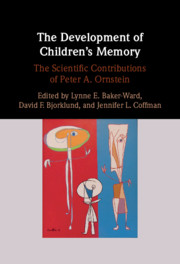Book contents
- The Development of Children’s Memory
- The Development of Children’s Memory
- Copyright page
- Dedication
- Contents
- Figures
- Tables
- Contributors
- Part I Backdrop
- Chapter 1 The Emergence of the Developmental Science of Memory
- Chapter 2 Mechanism or Meaning?
- Chapter 3 Memory Development or the Development of Memory?
- Part II Children’s Memory Strategies
- Part III Children’s Event Memory
- Part IV Family Socialization of Memory
- Part V Classroom Socialization of Memory
- Part VI Perspective
- References
- Index
Chapter 2 - Mechanism or Meaning?
The Ornstein Lab and Memory in Historical Context
from Part I - Backdrop
Published online by Cambridge University Press: 28 May 2021
- The Development of Children’s Memory
- The Development of Children’s Memory
- Copyright page
- Dedication
- Contents
- Figures
- Tables
- Contributors
- Part I Backdrop
- Chapter 1 The Emergence of the Developmental Science of Memory
- Chapter 2 Mechanism or Meaning?
- Chapter 3 Memory Development or the Development of Memory?
- Part II Children’s Memory Strategies
- Part III Children’s Event Memory
- Part IV Family Socialization of Memory
- Part V Classroom Socialization of Memory
- Part VI Perspective
- References
- Index
Summary
Over a century of memory research has swung between the two poles of the mechanistic model of Ebbinghaus and the adaptive, sociocultural, and organismic view of Bartlett, both of which were necessary but neither of which was essentially developmental. The Ornstein Lab has, over the last half century, with experimental rigor, explored how growing children use memory adaptively in meaningful contexts. From the transitional era of “verbal learning” in the 1950s to the cognitive revolution of the information-processing period in the 1980s, models of memory focused on the development of the deployment and control of strategic processes of remembering; models that, despite their modern sophistication, owe something to Ebbinghaus. But children grow up embedded in cultural structures of meanings ranging from the doctor’s office to the courtroom, aided or hindered by the people in them, intent on helping growing children to use memory adaptively within those cultural narratives.
Keywords
- Type
- Chapter
- Information
- The Development of Children's MemoryThe Scientific Contributions of Peter A. Ornstein, pp. 11 - 28Publisher: Cambridge University PressPrint publication year: 2021



